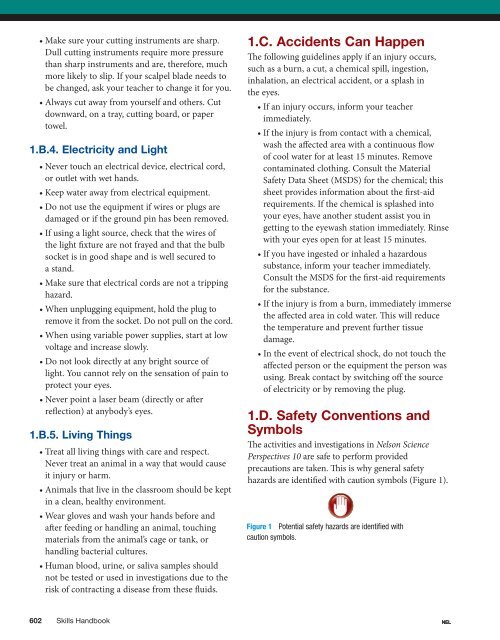PRE-PUBLICA TION EDITION - Nelson Education
PRE-PUBLICA TION EDITION - Nelson Education
PRE-PUBLICA TION EDITION - Nelson Education
Create successful ePaper yourself
Turn your PDF publications into a flip-book with our unique Google optimized e-Paper software.
• Make sure your cutting instruments are sharp.Dull cutting instruments require more pressurethan sharp instruments and are, therefore, muchmore likely to slip. If your scalpel blade needs tobe changed, ask your teacher to change it for you.• Always cut away from yourself and others. Cutdownward, on a tray, cutting board, or papertowel.1.B.4. Electricity and Light• Never touch an electrical device, electrical cord,or outlet with wet hands.• Keep water away from electrical equipment.• Do not use the equipment if wires or plugs aredamaged or if the ground pin has been removed.• If using a light source, check that the wires ofthe light fixture are not frayed and that the bulbsocket is in good shape and is well secured toa stand.• Make sure that electrical cords are not a trippinghazard.• When unplugging equipment, hold the plug toremove it from the socket. Do not pull on the cord.• When using variable power supplies, start at lowvoltage and increase slowly.• Do not look directly at any bright source oflight. You cannot rely on the sensation of pain toprotect your eyes.• Never point a laser beam (directly or afterreflection) at anybody’s eyes.1.B.5. Living Things• Treat all living things with care and respect.Never treat an animal in a way that would causeit injury or harm.• Animals that live in the classroom should be keptin a clean, healthy environment.• Wear gloves and wash your hands before andafter feeding or handling an animal, touchingmaterials from the animal’s cage or tank, orhandling bacterial cultures.• Human blood, urine, or saliva samples shouldnot be tested or used in investigations due to therisk of contracting a disease from these fluids.1.C. Accidents Can HappenThe following guidelines apply if an injury occurs,such as a burn, a cut, a chemical spill, ingestion,inhalation, an electrical accident, or a splash inthe eyes.• If an injury occurs, inform your teacherimmediately.• If the injury is from contact with a chemical,wash the affected area with a continuous flowof cool water for at least 15 minutes. Removecontaminated clothing. Consult the MaterialSafety Data Sheet (MSDS) for the chemical; thissheet provides information about the first-aidrequirements. If the chemical is splashed intoyour eyes, have another student assist you ingetting to the eyewash station immediately. Rinsewith your eyes open for at least 15 minutes.• If you have ingested or inhaled a hazardoussubstance, inform your teacher immediately.Consult the MSDS for the first-aid requirementsfor the substance.• If the injury is from a burn, immediately immersethe affected area in cold water. This will reducethe temperature and prevent further tissuedamage.• In the event of electrical shock, do not touch theaffected person or the equipment the person wasusing. Break contact by switching off the sourceof electricity or by removing the plug.1.D. Safety Conventions andSymbolsThe activities and investigations in <strong>Nelson</strong> SciencePerspectives 10 are safe to perform providedprecautions are taken. This is why general safetyhazards are identified with caution symbols (Figure 1).Figure 1 Potential safety hazards are identified withcaution symbols.602 Skills Handbook NEL
















